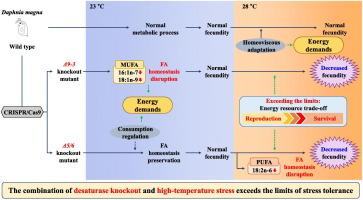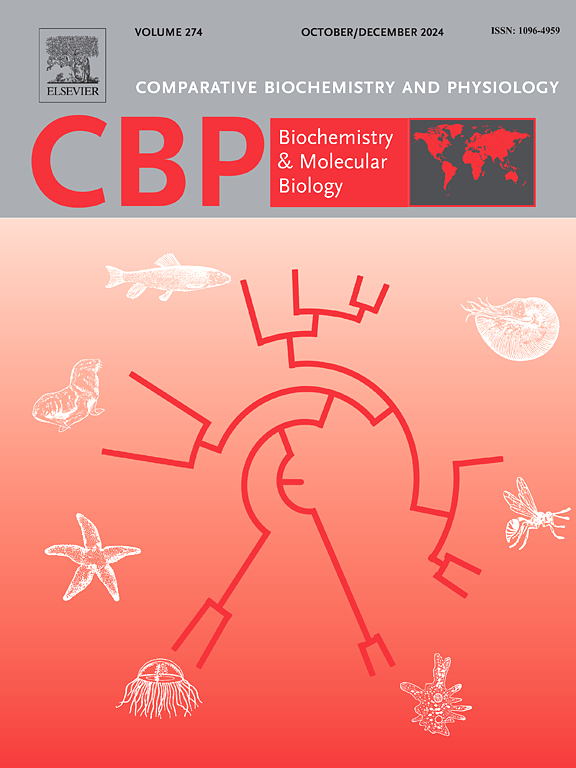大水蚤(Daphnia magna)两种去饱和酶(Δ9-3和Δ5/6)基因CRISPR/ cas9介导的基因靶向突变体在高温下对生命参数和脂肪酸表达谱的影响
IF 1.8
3区 生物学
Q4 BIOCHEMISTRY & MOLECULAR BIOLOGY
Comparative Biochemistry and Physiology B-Biochemistry & Molecular Biology
Pub Date : 2025-06-18
DOI:10.1016/j.cbpb.2025.111119
引用次数: 0
摘要
脂肪酸去饱和对恒温动物的膜稳态和热性能至关重要。我们用CRISPR/Cas9破坏了大水蚤(Daphnia magna)的Δ9-3 (mufa特异性)和Δ5/6(长链pufa特异性)去饱和酶基因,并在23 °C和28 °C下比较了野生型和敲除系。Δ9-3大量消耗的单不饱和脂肪酸,特别是油酸和棕榈油酸,随着总多不饱和脂肪酸的补偿性增加而减少。这些脂质变化与良性温度下的生长和繁殖力增强相一致,但在施加热应激时转化为生殖产量降低,表明了环境依赖的权衡。相反,Δ5/6的缺失在高温下选择性地破坏了n-6通路,导致PUFA总储备明显减少,后代产量严重下降;气候变暖通常带来的增长效益也被取消了。总之,数据显示Δ9-3支持基线代谢所需的多聚脂肪酸供应,而Δ5/6维持在热挑战下繁殖所需的多聚脂肪酸储备。因此,不同的去饱和酶功能在淡水浮游动物的脂质重塑和气候适应中发挥着不同的作用。本文章由计算机程序翻译,如有差异,请以英文原文为准。

Effects on life parameters and fatty acid expression profiles in response to elevated temperatures in CRISPR/Cas9-mediated gene–targeted mutants of two desaturase (Δ9–3 and Δ5/6) genes in the water flea Daphnia magna
Fatty-acid desaturation is central to membrane homeostasis and thermal performance in ectotherms. We disrupted the Δ9–3 (MUFA-specific) and Δ5/6 (long-chain PUFA-specific) desaturase genes in Daphnia magna with CRISPR/Cas9 and compared wild-type and knockout lines at 23 °C and 28 °C. Loss of Δ9–3 substantially depleted monounsaturated fatty acids, especially oleic and palmitoleic acids, with a compensatory rise in total polyunsaturates. These lipid shifts coincided with enhanced growth and fecundity under benign temperature but translated into reduced reproductive output when heat stress was imposed, indicating a context-dependent trade-off. In contrast, deletion of Δ5/6 selectively impaired the n-6 pathway at high temperature, leading to pronounced reductions in total PUFA reserves and a severe decline in offspring production; the usual growth benefit of warming was also abolished. Together, the data reveal that Δ9–3 supports MUFA supply needed for baseline metabolism, whereas Δ5/6 maintains PUFA reserves critical for reproduction under thermal challenge. Divergent desaturase functions thus play distinct roles in lipid remodeling and contribute to climate resilience in freshwater zooplankton.
求助全文
通过发布文献求助,成功后即可免费获取论文全文。
去求助
来源期刊
CiteScore
4.60
自引率
4.50%
发文量
77
审稿时长
22 days
期刊介绍:
Comparative Biochemistry & Physiology (CBP) publishes papers in comparative, environmental and evolutionary physiology.
Part B: Biochemical and Molecular Biology (CBPB), focuses on biochemical physiology, primarily bioenergetics/energy metabolism, cell biology, cellular stress responses, enzymology, intermediary metabolism, macromolecular structure and function, gene regulation, evolutionary genetics. Most studies focus on biochemical or molecular analyses that have clear ramifications for physiological processes.

 求助内容:
求助内容: 应助结果提醒方式:
应助结果提醒方式:


